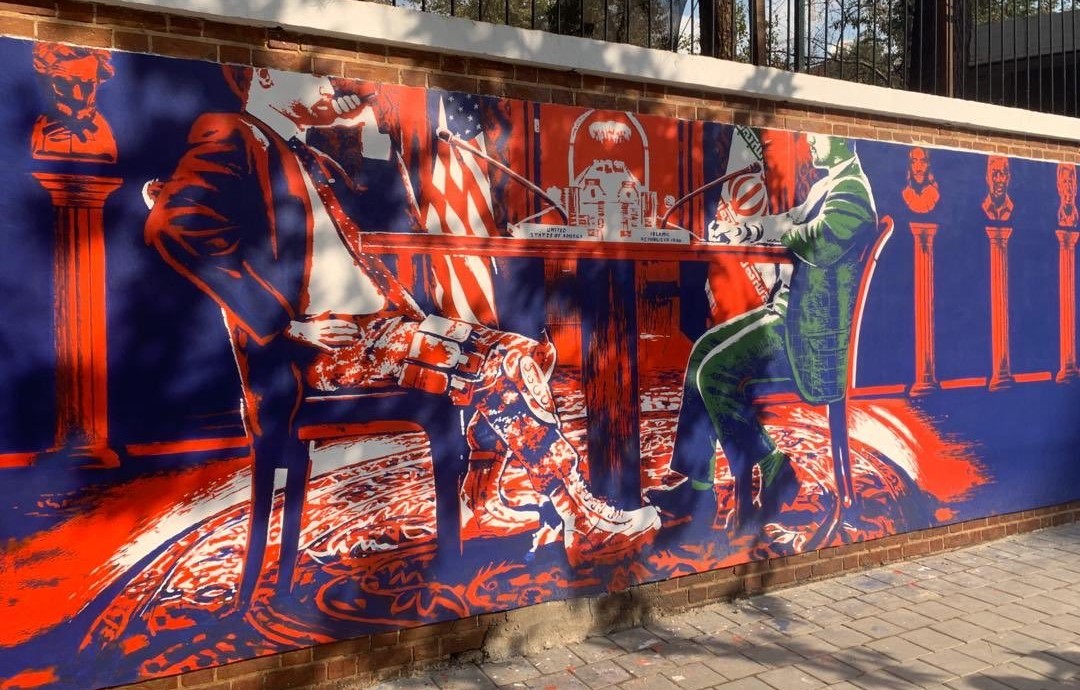Photo: A graffiti image from the wall of the U.S. Embassy in Tehran. This piece was created several years ago during the first round of nuclear negotiations. It depicts a plainly dressed man on the right, representing Iran, and a man on the left wearing a suit jacket but military trousers — a visual interpretation of distrust and tension. However, the image fails to reflect a critical reality: the brutal and bloody repression of critics and dissidents inside the country.
On March 31st, verbal threats between the United States and the Islamic Republic of Iran escalated to an unusual level. While Iranian officials hinted at a possible shift toward building a nuclear weapon, Donald Trump issued repeated statements signaling a potential military strike. This development is not just about Iran’s nuclear program. It reflects a wider U.S. strategy of projecting military strength — directed not only at Iran but also at other states seen as unwilling to align with U.S. global demands, including China, Canada, and Denmark.
Trump posted on his social media accounts that two weeks of airstrikes had seriously damaged Houthi positions in Yemen and would continue until Red Sea shipping lanes were secured. He ended with a direct warning:
“The choice before the Houthis is clear: stop attacking American ships, and we will stop firing. Otherwise, this is just the beginning. The real suffering is yet to come — for them and their backers in Iran.”
Earlier that same day, in an interview with NBC, Trump threatened Iran with a bombing campaign “like nothing ever seen before.” He repeated the same message to journalists hours later.
In Tehran and New York, the Islamic Republic responded by trying to show readiness without escalating directly. Khamenei’s Eid sermon included vague references to retaliation and internal unrest as a greater threat than war. At the United Nations, Iran’s ambassador Amir Saeid Iravani submitted a formal complaint, calling Trump’s threats a “clear violation” of international law and the UN Charter. The message echoed Khamenei’s stance in different terms:
“Iran strongly warns against any military adventure. Any attack by the United States or its regional proxy, Israel, will face a rapid and firm response.”
Strategic Deterrence and Tactical Messaging
What followed in Tehran was an attempt to raise the cost of war for Washington. Until recently, Iranian officials focused their threats on targeting U.S. military bases in the region and unveiling underground missile complexes. Now, the messaging shifted toward the nuclear issue, with Ali Larijani — senior advisor to Khamenei and former speaker of parliament — suggesting Iran could reconsider its nuclear stance in response to a U.S. attack.
In a television interview, Larijani emphasized Trump’s identity as a “businessman” and suggested economic cooperation could still be possible. This comes in sharp contrast to past official lines. After the 2015 nuclear deal, Khamenei had clearly stated that the U.S. would not be allowed to benefit from Iran’s post-sanctions economy:
“They intended to use the agreement as a tool for penetrating the country. We firmly blocked this path and will continue to do so. Neither economic nor political nor cultural infiltration will be allowed.”
Larijani’s statement seems to reflect a temporary tactical shift: Tehran is not rejecting negotiations outright but insists any agreement must preserve the regime’s domestic legitimacy and strategic position.
His second message was more direct — a warning that a limited military strike would not end with limited consequences. Instead, such a move could push Iran toward a full-scale nuclear program. He did not frame this as a new strategy but as an unavoidable reaction to external pressure.
“We’re under IAEA inspection and still committed to the fatwa against nuclear weapons. But if you make a mistake on our nuclear facilities, you’ll be the reason for Iran changing its decision. We’re not seeking weapons — but under military attack, we’ll be forced to act differently.”
More Than Iran: U.S. Military Threats as Global Messaging
Although the immediate confrontation is with the Islamic Republic, the logic behind Trump’s threats is not limited to Iran. As several reports suggest, this posture also serves as an indirect warning to other states — especially China — at a time when tensions over Taiwan are rising. It also targets countries such as Canada and Denmark, which have rejected or resisted key U.S. demands in recent months.
This logic resembles the strategy of George H. W. Bush in 1991. Back then, the U.S. used the rapid defeat of Iraq in the Gulf War to announce its dominance in the new unipolar world that had emerged after the fall of the Soviet Union. Today, in a different international context — one defined by multipolar tensions — Washington is again seeking to demonstrate the superiority of its military power.
A swift and destructive strike against Iran’s missile and nuclear facilities would serve that purpose — not only as a direct blow to the Islamic Republic but also as a strategic signal to other global actors. In a world that is no longer unipolar, such military gestures function as broader messages aimed at reaffirming U.S. dominance in an increasingly contested international arena.
This dynamic, however, is not one-sided. Other power blocs — particularly China and Russia — also rely on such escalations to justify their own military expansion and geopolitical assertiveness. Far from pushing toward de-escalation, multipolar competition often intensifies the arms race and the logic of confrontation. The recent remarks by China’s foreign minister, who stated that
eighty years after the end of World War II, we must work together to promote a multipolar world and democratize international relations,
reflect this approach. While presented in diplomatic language, such statements are part of a broader strategy to legitimize and extend China’s influence — including through increased military presence, regional interventions, and economic pressure.
In this context, a U.S. military strike on Iran is not merely about weakening a specific regime. It is a move within a larger game, where each major actor uses the aggression of its rival to justify its own policies. For Washington, preventing Iran from consolidating its regional position is both a tactical objective and a way to reinforce the message that U.S. military superiority remains intact — especially in the Middle East, where its dominance has been increasingly questioned. For Beijing and Moscow, any U.S. intervention helps support their narrative of Western aggression and strengthens their push for alternative security arrangements and regional alignments.


China maintains this position by supporting Iran’s military initiatives, aiming to challenge the United States in the Indian Ocean without direct confrontation. China is the supplier of the fuel needed for the IRGC’s missiles. Map: Diego Garcia Island, home to a joint U.S. and U.K. military base.
Authoritarian Consolidation on Both Sides
The Islamic Republic, for its part, uses the threat of war to consolidate power internally. Public references to nuclear capability are not only directed at Washington but also serve as signals to a domestic audience — showing defiance and projecting strength at a time of deep social and economic crisis. Meanwhile, mass arrests, executions, and suppression of dissent continue across the country.
This dual-use of war threats — for international bargaining and internal control — mirrors patterns seen in other authoritarian states. It is not about defending sovereignty. It is about regime preservation.
The current crisis cannot be understood by looking only at Iran or only at the U.S. It is a product of a global system where military power is central to both imperial and regional politics. While the U.S. continues to act as a declining empire trying to reassert control, the Islamic Republic functions as a militarized state seeking to survive through external confrontation and internal repression.
The potential for war remains high. But this is not simply a bilateral issue. It is connected to the broader international system — and to the absence of a global movement capable of challenging the logic of war, militarism, and state violence on all sides.
What’s missing is not another negotiation between elites, but coordinated political opposition to war from below: across borders, against all forms of authoritarianism, and in defense of civil and social rights — in Iran, in the U.S., and elsewhere.










